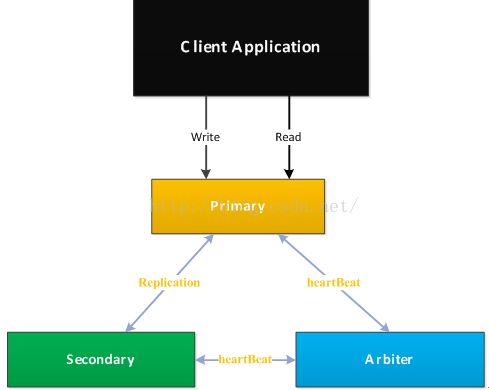mongodb副本集
Mongodb 副本集
mongodb支持副本集,通过异步复制 来达到故障转移和冗余,以保证一台服务器挂了以后数据依旧有备份。
mongodb的高可用采用两种策略:
1、主从复制
某一个服务启动加上-master参数,另一个服务加上-slave及-source选项
2、副本集
为mongodb推荐使用方式,能够实现故障自动切换。
通过oplog实现数据复制,oplog是个固定集合,在默认情况下,oplog占用磁盘空闲空间的5%,这个值可修改
主从节点
一般副本集会采用主节点、副节点及仲裁节点,不过仲裁节点不是必须的,本文先不适用仲裁节点,其架构方式为:
副本集1 :28010
副本集2: 28011
其配置文件1为:
replSet=rs1
#keyFile=/root/data/shard/key/r0
fork=true
port=28010
dbpath=/root/data/shard/s0
logpath=/root/data/shard/log/r0.log
logappend=true
directoryperdb=true配置文件2为:
replSet=rs1
#keyFile=/root/data/shard/key/r1
fork=true
port=28011
dbpath=/root/data/shard/s1
logpath=/root/data/shard/log/r1.log
logappend=true
directoryperdb=true步骤:
1. 启动mongod进程
# mongod -f s0.conf
about to fork child process, waiting until server is ready for connections.
forked process: 30513
child process started successfully, parent exiting
#mongod -f s1.conf
about to fork child process, waiting until server is ready for connections.
forked process: 30536
child process started successfully, parent exiting2、进入某一个实例# mongo -port28010
3、初始化副本集表
config_rs1={_id:"rs1",members:[]}
{ "_id" : "rs1", "members" : [ ] }
> config_rs1.members.push({_id:0,host:"localhost:28010"})
1
> config_rs1.members.push({_id:1,host:"localhost:28011"})
2
> rs.initiate(config_rs1)
{ "ok" : 1 }查看数据信息
1、rs1:OTHER> rs.isMaster()
{
"hosts" : [
"localhost:28010",
"localhost:28011"
],
"setName" : "rs1",
"setVersion" : 1,
"ismaster" : true,
"secondary" : false,
"primary" : "localhost:28010",
"me" : "localhost:28010",
…
}其中主要的几个属性:
isMaster,是否为主节点
secondary:是否为从节点
primary:指出当前副本集中的主节点位于哪个进程
2.查看详细的配置信息
rs1:PRIMARY> rs.config()
{
"_id" : "rs1",
"version" : 1,
"protocolVersion" : NumberLong(1),
"members" : [
{
"_id" : 0,
"host" : "localhost:28010",
"arbiterOnly" : false,
"buildIndexes" : true,
"hidden" : false,
"priority" : 1,
"tags" : {
},
"slaveDelay" : NumberLong(0),
"votes" : 1
},
{
"_id" : 1,
"host" : "localhost:28011",
"arbiterOnly" : false,
"buildIndexes" : true,
"hidden" : false,
"priority" : 1,
"tags" : {
},
"slaveDelay" : NumberLong(0),
"votes" : 1
}
],
"settings" : {
…
}
}3.查看副本集的当前状态:
rs1:SECONDARY>rs.status()
{
"set" : "rs1",
"date" : ISODate("2016-09-16T06:55:46.351Z"),
"myState" : 2,
"term" : NumberLong(1),
"syncingTo" : "localhost:28010",
"heartbeatIntervalMillis" : NumberLong(2000),
"members" : [
{
"_id" : 0,
"name" : "localhost:28010",
"health" : 1,
"state" : 1,
"stateStr" : "PRIMARY",
…
},
{
"_id" : 1,
"name" : "localhost:28011",
"health" : 1,
"state" : 2,
"stateStr" : "SECONDARY",
…
"syncingTo" : "localhost:28010",
"self" : true
}
],
"ok" : 1
}该命令是在从节点完成,myState为2,代表为从节点,1为主节点。从节点以心跳包的方式与主节点查看服务器是否正常。
4.查看同步情况:
rs1:PRIMARY> use local
switched to db local
rs1:PRIMARY> db.oplog.rs.find()
{ "ts" : Timestamp(1474008594, 1), "h" : NumberLong("6036013166154382110"), "v" : 2, "op" : "n", "ns" : "", "o" : { "msg" : "initiating set" } }
{ "ts" : Timestamp(1474008606, 1), "t" : NumberLong(1), "h" : NumberLong("1907052058849733960"), "v" : 2, "op" : "n", "ns" : "", "o" : { "msg" : "new primary" } }
在初始化副本集集合完成之后,日志的记录为initiating set.
查看同步状态:
rs1:PRIMARY> db.printSlaveReplicationInfo()
source: localhost:28011
syncedTo: Fri Sep 16 2016 15:00:14 GMT+0800 (CST)
0 secs (0 hrs) behind the primary
rs1:PRIMARY> db.printReplicationInfo()
configured oplog size: 13185.910937309265MB
log length start to end: 620secs (0.17hrs)
oplog first event time: Fri Sep 16 2016 14:49:54 GMT+0800 (CST)
oplog last event time: Fri Sep 16 2016 15:00:14 GMT+0800 (CST)
now: Fri Sep 16 2016 15:59:01 GMT+0800 (CST)插入数据,实现读写分离
rs1:PRIMARY> use test
switched to db test
rs1:PRIMARY> db.dev.insert({"name":"camel"})在从节点查看数据,首先设置从节点可读
rs1:SECONDARY> db.getMongo().setSlaveOk()
rs1:SECONDARY> use test
switched to db test
rs1:SECONDARY> db.dev.insert("name":"camel")故障恢复
无论哪一个发生了故障,如使用kill命令或者使用shutdownServer命令。另外一个将变成从节点。状态为:SECONDARY。
rs1:SECONDARY> use admin
switched to db admin
rs1:SECONDARY> db.shutdownServer()此时希望直接读取这个节点的内容:
rs1:SECONDARY> use test
switched to db test
rs1:SECONDARY> show collections
2016-09-16T16:19:54.879+0800 E QUERY [thread1] Error: listCollections failed: { "ok" : 0, "errmsg" : "not master and slaveOk=false", "code" : 13435 } :
…于是我们设置可读
rs1:SECONDARY> rs.slaveOk()
rs1:SECONDARY> show collections
dev主、副、仲裁节点
如果是直接使用rs.remove(“localhost:28011”),移除节点。那么28010将成为唯一可用的节点,即没有备份。
这种方式显然有些不够合理,需要手动去设置节点可以读写,那么三个节点:主、副、仲裁节点,其架构方式将为:
插入新节点:
rs1:PRIMARY> rs.add({_id:3,host:"localhost:28012",arbiterOnly:true})
{ "ok" : 1 }查看当前的信息
rs1:PRIMARY> rs.isMaster()
{
"hosts" : [
"localhost:28011",
"localhost:28010"
],
"arbiters" : [
"localhost:28012"
],
"setName" : "rs1",
"setVersion" : 6,
"ismaster" : true,
"secondary" : false,
"primary" : "localhost:28011",
"me" : "localhost:28011",
"ok" : 1
…
}在主节点上直接shutdownServer,查看从节点,此时
rs1:PRIMARY> rs.isMaster()
{
"hosts" : [
"localhost:28011",
"localhost:28010"
],
"arbiters" : [
"localhost:28012"
],
"setName" : "rs1",
"setVersion" : 6,
"ismaster" : true,
"secondary" : false,
"primary" : "localhost:28010",
"me" : "localhost:28010",
…}s1:PRIMARY> rs.status()
{
"set" : "rs1",
"date" : ISODate("2016-09-16T08:36:27.466Z"),
"myState" : 1,
"term" : NumberLong(7),
"heartbeatIntervalMillis" : NumberLong(2000),
"members" : [
{
"_id" : 1,
"name" : "localhost:28011",
"health" : 0,
"state" : 8,
"stateStr" : "(not reachable/healthy)",
…28010已经处于不健康的状态。
主、从、从
rs1:SECONDARY> rs.status()
{
"set" : "rs1",
"date" : ISODate("2016-09-16T09:18:29.102Z"),
"myState" : 2,
"term" : NumberLong(8),
"heartbeatIntervalMillis" : NumberLong(2000),
"members" : [
{
"_id" : 1,
"name" : "localhost:28011",
"health" : 0,
"state" : 8,
"stateStr" : "(not reachable/healthy)",
"uptime" : 0,
"optime" : {
"ts" : Timestamp(0, 0),
"t" : NumberLong(-1)
},
"optimeDate" : ISODate("1970-01-01T00:00:00Z"),
"lastHeartbeat" : ISODate("2016-09-16T09:18:27.031Z"),
"lastHeartbeatRecv" : ISODate("2016-09-16T09:18:04.818Z"),
"pingMs" : NumberLong(0),
"lastHeartbeatMessage" : "Connection refused",
"configVersion" : -1
},
{
"_id" : 2,
"name" : "localhost:28010",
"health" : 0,
"state" : 8,
"stateStr" : (not reachable/healthy)"
"uptime" : 0,
"optime" : {
"ts" : Timestamp(0, 0),
"t" : NumberLong(-1)
},
"optimeDate" : ISODate("1970-01-01T00:00:00Z"),
"lastHeartbeat" : ISODate("2016-09-16T09:18:25.863Z"),
"lastHeartbeatRecv" : ISODate("2016-09-16T09:15:48.264Z"),
"pingMs" : NumberLong(0),
"lastHeartbeatMessage" : "Connection refused",
"configVersion" : -1
},
{
"_id" : 3,
"name" : "localhost:28012",
"health" : 1,
"state" : 2,
"stateStr" : "SECONDARY",
"uptime" : 376,
"optime" : {
"ts" : Timestamp(1474017358, 2),
"t" : NumberLong(8)
},
"optimeDate" : ISODate("2016-09-16T09:15:58Z"),
"infoMessage" : "could not find member to sync from",
"configVersion" : 10,
"self" : true
}
],
"ok" : 1
}

